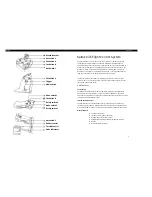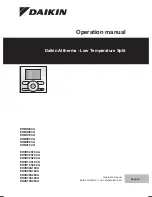
VER. 001_28.06.2016
VER. 001_28.06.2016
DESCRIPTION OF THE LCD DISPLAY
DESCRIPTION OF THE FUNCTIONS OF INDIVIDUAL BUTTONS
CLOCK SETTING
1. Power failure symbol
– displayed when there is no power supply (not connected or
failure)
2. Setting mode symbo
l – displayed at the procedure of the setting of controller parameters
3. Freezing prevention function symbol
– displayed when the temperature in the room is
lower than that set as the minimum temperature preventing freezing.
4. Heating symbol
– displayed when the output relay which switches on the load is ON, this
occurs when the temperature in the room is lower than that set.
5. Temperature in the room
– the temperature from the internal or external sensor is di-
splayed, and when the sensor failed (error code Err1, or Err2, depends on the sensor
used.
6. Days of week in the room
– displayed are days of week (1…7)
7. Clock and temperature setting
– time/temperature is displayed alternately.
8. Operation (timed) program
– time schedule of the operation is displayed P1 up to P4.
9. Keyboard lock symbol
– displayed when the keyboard is locked.
Button: “ ”
Pressed for short time: in/out from selection mode.
Button: “+”
Pressed for short time: increasing the setting value by 1. Pressed and hold: quick increment
of the setting value.
Button: “-”
Pressed for short time: decreasing the setting value by 1. Pressed and hold: quick decrement
of the setting value.
Button: “ ”
Pressed for short time: switching between displaying the temperature from the internal and external sensor,
or entering/leaving setting mode. Pressed and hold: ON / OFF.
„LED”
Not used in the RTP-01 temperature controller.
Note: pressing and holding “+” and “-” buttons simultaneously makes the keyboard locked
or unlocked.
In normal mode press shortly the “ ” button once to switch to the mode selection status;
this will the symbol “F0” light flashing, then press the “ ” button to switch to the clock
setting mode and flashing the of week day field.
•
Keep pressing buttons “+” / “-”, to set week day, then press “ ” button to set hour.
•
Keep pressing buttons “+” / “-”, to set hour, then press “ ” button to set minutes.
•
Keep pressing buttons “+” / “-”, to set minutes, then press “ ” button to go back
to the selection mode status.
1
6
2
7
3
8
4
5
9
SETTING THE OPERATION PROGRAM
(operating within the following setting values in automatic mode)
Default timed operation program:
Time period
(operation time span)
Start time
(commencement time)
Temperature setting (°C)
Mon. – Fri.
(Monday through Friday)
Sat. – Sun.
(Saturday through Sunday)
P1: 6:00 – 8:00
6:00
25 °C
25 °C
P2: 8:00 – 16:00
8:00
10 °C
10 °C
P3: 16:00 – 22:00
16:00
25 °C
25 °C
P4: 22:00 – 6:00
22:00
15 °C
15 °C
The user can edit the timed operation program – editing relates to the operation time span and relative temperature value according to the following
description:
● In the selection mode press the “+/-” button to select “F1”. ● Press the “ ” button to switch to the schedule of the timed operation, the “1-----5” week day field
should flash. ● Keep pressing “+” / “-“ buttons to select week day: 1 2 3 4 5 / 6 / 7. ● After setting press “ ” button to confirm the selection and switch to the
mode of the operation span time setting; symbol “P1” should flash. ● Keep pressing “+” / “-“ buttons to select time span: P1/P2/P3/P4.
After setting press “ ” button to confirm the selection and switch to the mode of the operation span time setting; respective P1/P2/P3/P4 symbol should flash.
● Keep pressing “+” / “-“ buttons to select operation time span. Short, one press of the button makes the operation time lower or higher by 15 minutes.
Please note the time set restriction: 0:00 <P1<P2<P3<P4<23:59. After setting press “ ” button to confirm settings and to switch to the temperature settings
for individual operation times; temperature setting field should flash. ● Keep pressing “+” / “-“ buttons to set temperature, pressing the button once makes the
temperature setting increased / decreased by 1 ºC; allowable set value range: min. 5 ºC → 6 ºC →→ 45 ºC max.; press “ ” button to confirm the setting and to
switch to the next operation time. ● Repeat operations until four operation time ranges are set for working days (1 2 3 4 5) and then switch to the setting of the
operation time on Saturday. ● Entering this mode is indicated by “6” symbol flashing in the week day field. The setting mode is the same as described above.
After setting press “ ” button to switch to the setting of the operation times on Sunday (7). The setting mode is the same as described above. After setting press
“ ” button to switch to go back to the selection mode.
Note: if the devise is not operated within 10 seconds it returns to the normal operation status.
SETTING THE PROTECTION SYSTEM AGAINST TOO HIGH TEMPERATURE
SETTING THE “FREEZING PROTECTION” TEMPERATURE
CALIBRATION OF THE INTERNAL SENSOR
SETTING OF THE MEMORY FUNCTIONS
DESCRIPTION OF THE OPERATION STATE
POWER FAILURE STATUS
SETTING THE SENSOR OPERATION MODE
● In the status selection mode keep pressing “+” / ”-” buttons to select “F2”. ● Press “ ” button to set the maximum temperature value. ● Keep pressing
“+” / “-” buttons to chose the setting; pressing the button each time makes the setting changed by 1°C. ● The default setting is 50°C (maximum allowable
adjustment range is 40 up to 70°C). ● After setting press “ ” button to return to the selection mode.
● In the status selection mode keep pressing “+” / “-” buttons to select “F3”. ● Press the “ ” button to set the “freezing protection” temperature. ● Keep
pressing the “+” / “-” buttons to chose the setting; pressing the button each time makes the setting changed by 1°C; the default setting is 3°C (maximum
allowable adjustment range is 2 up to 10°C. ● After setting press the “ ” button to return to the selection mode.
● In the status selection mode keep pressing “+” / “-” buttons to select “F4”. ● Press the “ ” button to enter the internal sensor calibration mode. ● Keep
pressing the “+” / “-” buttons to corrective value (0 up to 15°C) which is deducted from the current temperature value of the internal sensor; pressing the
button once makes the setting increased/decreased by 1°C. ● Press the “ ” button to return to the selection mode.
● In the selection mode keep pressing the “+” / “-” buttons to select “F6”. ● Press the “ ” button; the “0”. “0” should flash. When switching off the power
supply and then switching it on again after more than about 2 hours the temperature controller goes to the “OFF” status. “1”. When switching off the po-
wer supply and then switching it on again after about 2 hours the temperature controller goes to operation mode it was before the switching off the power
supply. ● Keep pressing the “+” / “-” buttons to select the requires mode. ● Press the “ ” button to confirm the setting and return to the selection mode.
In normal operation state the current our, temperature from the check sensor, and the symbol of the current ope-
ration time range (P1÷P4), as presented in the drawing.
If the device operates in the manual mode, no symbol of the current operation time range is displayed.
Pressing the “ ” button for short time: checking the temperature of the second sensor.
Pressing the “ ” button for longer time: switching between ON and OFF.
Pressing the “ ” button for short time: switching to selection mode status, keep pressing the “+” / “-” buttons to
select the (F0 – F6) mode; press the “ ” button to switch to the mode or value selection.
Pressing the “+” / “-” button for short time makes the setting values increased or decreased.
Pressing and holding the “+” button for more than 5 seconds: switching to the default values of the temperature
controller. Pressing and holding the “-” button for more than 5 seconds: switching between automatic/manual mode.
If the devise is disconnected from the mains or a power supply failure occurs the system retains all the current
settings and goes to the standby mode: only time and week day is displayed, as well as the power failure symbol
(left hand upper corner). After switching the power supply on before about 2 hours elapse the system automatical-
ly returns to the normal operation mode. If the controller has been disconnected from the power supply for more
than about 2 hours, the clock and week day readings become shortly incorrect, and the system, after the power
supply is restored, will set these values randomly. The temperature controller does not lose its settings introduced
into the menu F0 – F6 tabs when programming. When the power supply is back after the time longer than about
2 hours the device automatically comes on and enters the operation mode in accordance to the settings in the
menu F6 tab of the controller, i.e.
• the temperature controller enters the “OFF” mode – the “0” parameter in the F6 tab.
• the temperature controller enters the mode it was before the power supply failure – the “1” parameter in the F6 tab.
● In the selection mode press the “+” / “-” buttons to select “F5”. ● Press the “ ” button to go to the sensor ope-
ration selection: the default value is “1”, as presented in the drawing below. ● In order to set the selected the
operation mode of the sensors keep pressing the “+” / “-” buttons to select one of the modes (Mode 0 – Mode
1 – Mode 2). ● Press the “ ” button to confirm and go back to the mode selection.
Sensor operation modes:
Mode
Parameter in the “F5” tab.
Time
MODE 0
0
temperature checked by the internal sensor,
the external sensor for limiting the temperature
MODE 1
1
temperature checked by the internal sensor
MODE 2
2
temperature checked by the external sensor
Table of errors:
Error code
Error description
Procedures
Err1
Internal sensor damaged
-
Err2
External sensor damaged
or wrong connection
● check the connection of the NTC sensor to the RTP-01
temperature controller ● check the NTC probe operation
● the resistance of the probe should be 5kΩ at 25°C
Err3
Internal or external sensor damaged
in the MODE 0 / wrong connection
of the external sensor
● check the connection of the NTC sensor to the RTP-01
temperature controller ● check the NTC probe operation ● the
resistance of the probe should be 5kΩ at 25°C ● if the probe is in
good working order and connected properly, it means that the internal
sensor is damaged




















